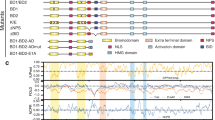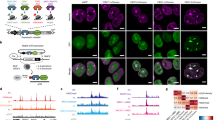Abstract
A key step in many chromatin-related processes is the recognition of histone post-translational modifications by effector modules such as bromodomains and chromo-like domains of the Royal family1,2. Whereas effector-mediated recognition of single post-translational modifications is well characterized3, how the cell achieves combinatorial readout of histones bearing multiple modifications is poorly understood. One mechanism involves multivalent binding by linked effector modules4. For example, the tandem bromodomains of human TATA-binding protein-associated factor-1 (TAF1) bind better to a diacetylated histone H4 tail than to monoacetylated tails, a cooperative effect attributed to each bromodomain engaging one acetyl-lysine mark5. Here we report a distinct mechanism of combinatorial readout for the mouse TAF1 homologue Brdt, a testis-specific member of the BET protein family6. Brdt associates with hyperacetylated histone H4 (ref. 7) and is implicated in the marked chromatin remodelling that follows histone hyperacetylation during spermiogenesis, the stage of spermatogenesis in which post-meiotic germ cells mature into fully differentiated sperm7,8,9,10. Notably, we find that a single bromodomain (BD1) of Brdt is responsible for selectively recognizing histone H4 tails bearing two or more acetylation marks. The crystal structure of BD1 bound to a diacetylated H4 tail shows how two acetyl-lysine residues cooperate to interact with one binding pocket. Structure-based mutagenesis that reduces the selectivity of BD1 towards diacetylated tails destabilizes the association of Brdt with acetylated chromatin in vivo. Structural analysis suggests that other chromatin-associated proteins may be capable of a similar mode of ligand recognition, including yeast Bdf1, human TAF1 and human CBP/p300 (also known as CREBBP and EP300, respectively). Our findings describe a new mechanism for the combinatorial readout of histone modifications in which a single effector module engages two marks on a histone tail as a composite binding epitope.
This is a preview of subscription content, access via your institution
Access options
Subscribe to this journal
Receive 51 print issues and online access
$199.00 per year
only $3.90 per issue
Buy this article
- Purchase on Springer Link
- Instant access to full article PDF
Prices may be subject to local taxes which are calculated during checkout



Similar content being viewed by others
References
Berger, S. L. The complex language of chromatin regulation during transcription. Nature 447, 407–412 (2007)
Kouzarides, T. Chromatin modifications and their function. Cell 128, 693–705 (2007)
Taverna, S. D., Li, H., Ruthenburg, A. J., Allis, C. D. & Patel, D. J. How chromatin-binding modules interpret histone modifications: lessons from professional pocket pickers. Nature Struct. Mol. Biol. 14, 1025–1040 (2007)
Ruthenburg, A. J., Li, H., Patel, D. J. & Allis, C. D. Multivalent engagement of chromatin modifications by linked binding modules. Nature Rev. Mol. Cell Biol. 8, 983–994 (2007)
Jacobson, R. H., Ladurner, A. G., King, D. S. & Tjian, R. Structure and function of a human TAFII250 double bromodomain module. Science 288, 1422–1425 (2000)
Florence, B. & Faller, D. V. You BET-cha: a novel family of transcriptional regulators. Front. Biosci. 6, d1008–d1018 (2001)
Pivot-Pajot, C. et al. Acetylation-dependent chromatin reorganization by BRDT, a testis-specific bromodomain-containing protein. Mol. Cell. Biol. 23, 5354–5365 (2003)
Shang, E., Nickerson, H. D., Wen, D., Wang, X. & Wolgemuth, D. J. The first bromodomain of Brdt, a testis-specific member of the BET sub-family of double-bromodomain-containing proteins, is essential for male germ cell differentiation. Development 134, 3507–3515 (2007)
Govin, J., Caron, C., Lestrat, C., Rousseaux, S. & Khochbin, S. The role of histones in chromatin remodelling during mammalian spermiogenesis. Eur. J. Biochem. 271, 3459–3469 (2004)
Rousseaux, S. et al. Establishment of male-specific epigenetic information. Gene 345, 139–153 (2005)
Crowley, T. E., Kaine, E. M., Yoshida, M., Nandi, A. & Wolgemuth, D. J. Reproductive cycle regulation of nuclear import, euchromatic localization, and association with components of Pol II mediator of a mammalian double-bromodomain protein. Mol. Endocrinol. 16, 1727–1737 (2002)
Leroy, G., Rickards, B. & Flint, S. J. The double bromodomain proteins Brd2 and Brd3 couple histone acetylation to transcription. Mol. Cell 30, 51–60 (2008)
Ladurner, A. G., Inouye, C., Jain, R. & Tjian, R. Bromodomains mediate an acetyl-histone encoded antisilencing function at heterochromatin boundaries. Mol. Cell 11, 365–376 (2003)
Matangkasombut, O. & Buratowski, S. Different sensitivities of bromodomain factors 1 and 2 to histone H4 acetylation. Mol. Cell 11, 353–363 (2003)
Toyama, R., Rebbert, M. L., Dey, A., Ozato, K. & Dawid, I. B. Brd4 associates with mitotic chromosomes throughout early zebrafish embryogenesis. Dev. Dyn. 237, 1636–1644 (2008)
Dey, A., Chitsaz, F., Abbasi, A., Misteli, T. & Ozato, K. The double bromodomain protein Brd4 binds to acetylated chromatin during interphase and mitosis. Proc. Natl Acad. Sci. USA 100, 8758–8763 (2003)
Dey, A. et al. A bromodomain protein, MCAP, associates with mitotic chromosomes and affects G2-to-M transition. Mol. Cell. Biol. 20, 6537–6549 (2000)
Mujtaba, S., Zeng, L. & Zhou, M. M. Structure and acetyl-lysine recognition of the bromodomain. Oncogene 26, 5521–5527 (2007)
Owen, D. J. et al. The structural basis for the recognition of acetylated histone H4 by the bromodomain of histone acetyltransferase Gcn5p. EMBO J. 19, 6141–6149 (2000)
Kanno, T. et al. Selective recognition of acetylated histones by bromodomain proteins visualized in living cells. Mol. Cell 13, 33–43 (2004)
Polesskaya, A. et al. Interaction between acetylated MyoD and the bromodomain of CBP and/or p300. Mol. Cell. Biol. 21, 5312–5320 (2001)
Wei, L., Jamonnak, N., Choy, J., Wang, Z. & Zheng, W. Differential binding modes of the bromodomains of CREB-binding protein (CBP) and p300 with acetylated MyoD. Biochem. Biophys. Res. Commun. 368, 279–284 (2008)
Govin, J. et al. Pericentric heterochromatin reprogramming by new histone variants during mouse spermiogenesis. J. Cell Biol. 176, 283–294 (2007)
Kabsch, W. Automatic processing of rotation diffraction data from crystals of initially unknown symmetry and cell constants. J. Appl. Cryst. 26, 795–800 (1993)
CCP4. The CCP4 suite: programs for protein crystallography. Acta Crystallogr D 50, 760–763 (1994)
Storoni, L. C., McCoy, A. J. & Read, R. J. Likelihood-enhanced fast rotation functions. Acta Crystallogr D 60, 432–438 (2004)
Emsley, P. & Cowtan, K. Coot: model-building tools for molecular graphics. Acta Crystallogr D 60, 2126–2132 (2004)
Brünger, A. T. et al. Crystallography & NMR system: a new software suite for macromolecular structure determination. Acta Crystallogr D 54, 905–921 (1998)
Acknowledgements
We thank the ESRF and EMBL staff for beamline assistance, the Partnership for Structural Biology (PSB) for access to technical platforms, M. Jamin for MALLS experiments, G. Natrajan and V. Rybin for help with ITC, C. Soucier for help with FRAP, D. Panne and C. Clapier for comments on the manuscript, and S. Cusack for critical support. Work in the S.K. laboratory was supported by ANR blanche ‘EpiSperm’ and ‘Empreinte’, INCa and ‘ARECA’ (ARC) research programmes. J.Ga. was supported by a Ph.D. fellowship from the Rhône-Alpes region. J.M. was supported by an ‘E-STAR’ fellowship funded by EU FP6. C.P. acknowledges support from the ANRS/Fondation de France AIJC and CNRS ATIP programmes.
Author Contributions M.S.-L., D.J.H., S.K. and C.W.M. initiated the study. S.K., C.P. and C.W.M. coordinated the entire project and specific author contributions. J.M., S.R., U.S., M.S.-L., A.-L.V. and D.J.H. prepared constructs. J.M., U.S. and M.S.-L. expressed, purified and crystallized BD1 and BD2. J.M. and U.S. performed and analysed ITC and biophysical experiments. J.M., M.S.-L. and C.P. measured diffraction data and solved the crystal structures. C.P. and C.W.M. analysed structural and biochemical data. J.Go. performed immunoblot analysis and immunofluorescence microscopy. S.C. and S.R. performed FRAP and chromatin compaction experiments. J.Ga. prepared histones for MS/MS analysis. K.S. and J.K. performed the MS/MS analysis. C.P. wrote the manuscript. All authors discussed the results and commented on the manuscript.
Author information
Authors and Affiliations
Corresponding author
Supplementary information
Supplementary Information
This file contains Supplementary Tables 1-2 and Supplementary Figures 1-13 with Legends and Supplementary References. (PDF 7303 kb)
Rights and permissions
About this article
Cite this article
Morinière, J., Rousseaux, S., Steuerwald, U. et al. Cooperative binding of two acetylation marks on a histone tail by a single bromodomain. Nature 461, 664–668 (2009). https://doi.org/10.1038/nature08397
Received:
Accepted:
Issue Date:
DOI: https://doi.org/10.1038/nature08397
This article is cited by
-
Bromodomain inhibitor i-BET858 triggers a unique transcriptional response coupled to enhanced DNA damage, cell cycle arrest and apoptosis in high-grade ovarian carcinoma cells
Clinical Epigenetics (2023)
-
Defining super-enhancers by highly ranked histone H4 multi-acetylation levels identifies transcription factors associated with glioblastoma stem-like properties
BMC Genomics (2023)
-
Methylation of BRD4 by PRMT1 regulates BRD4 phosphorylation and promotes ovarian cancer invasion
Cell Death & Disease (2023)
-
Epigenetic mechanisms to propagate histone acetylation by p300/CBP
Nature Communications (2023)
-
Structure and function of retroviral integrase
Nature Reviews Microbiology (2022)
Comments
By submitting a comment you agree to abide by our Terms and Community Guidelines. If you find something abusive or that does not comply with our terms or guidelines please flag it as inappropriate.



